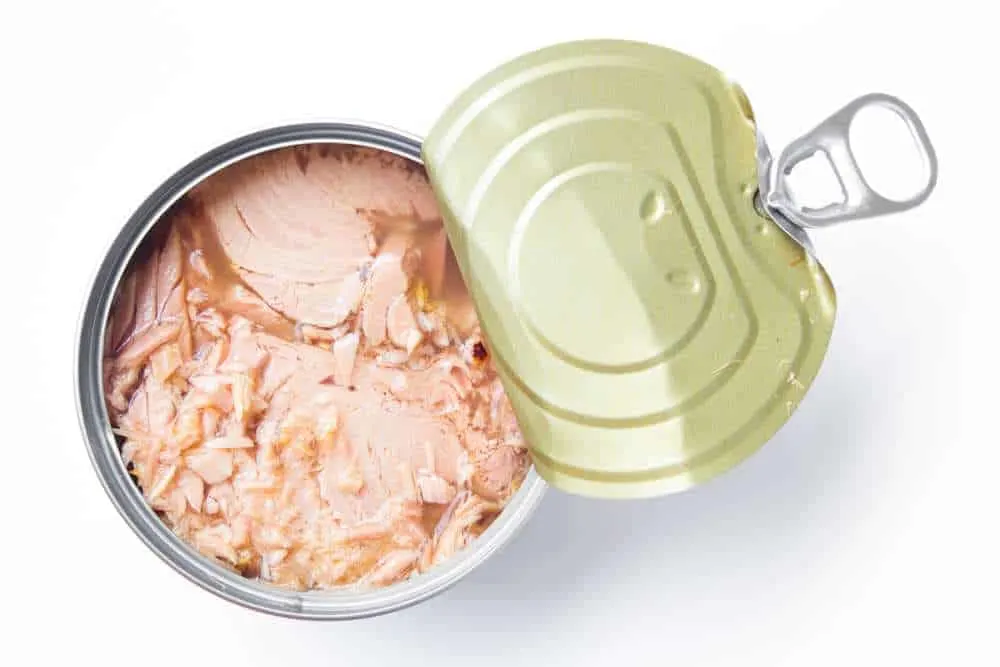Lately, a lot of pet parents are trying hard to improve their pet’s diets. I am a great supporter of this movement, honestly, since I’m trying hard as well to serve more wholesome and nutritious meals to my pup than a bowl full of plain dry food.
Is there a healthy meal plan that does not include fish? Yes, of course, but fish is a great source of protein for dogs, and it should not be excluded from their diet! The problem may occur when you need to choose what fish to serve to your pooch.
The first thing that comes to your mind will logically be – tuna. More likely canned tuna. However, did it come to your mind, can dogs eat canned tuna considering all the issues surrounding this particular product?
Today I will discuss all the pros and cons of feeding your dog with canned tuna.

Is Canned Tuna Good For Dogs?
When considering the question is tuna good for dogs, you need to keep in mind that a healthy diet for dogs is a combination of lots of different ingredients and nutrients.
If you feed your pup with versatile ingredients, you will help them build strong bones and organs, improve their cognitive skills, and enhance their overall health. Dogs need strong muscles, and for that, they will need a lot of proteins and the right fats (omega fatty acids) as well as vitamins and minerals.
Free-range tuna contain high levels of vitamin B, magnesium, potassium, selenium, and phosphorus. That means tuna is a great source of all the necessary nutrients dogs need to build a strong and healthy body.
So if feeding your dog with tuna can provide a lot of benefits, why do many dog owners still choose supplements like fish oils & weeds over canned fish?
Downsides Of Canned Tuna In A Dogs Diet
Is tuna acceptable in canned form in a dog’s diet? My answer is no; experts would say it should be avoided.
Well, logically, a fresh fish from the fisherman or store is a better option for sure since it was simply cleaned, filleted, and refrigerated plain and with no added ingredients. On the other hand, canned tuna is preserved so that we can keep it in the cupboard for a long time. So you can see where the problem occurs.
Canned tuna is more accessible and affordable; there is no discussion about that, but if we humans can eat canned tuna with no side effects, why can’t dogs?
There are two simple answers to that question, and those are additives in liquid solutions used for preserving fish and mercury.
Liquid solutions like brine, oil, or any other juice and preservative agents that can be found in canned tuna are not safe for dogs. Let’s first talk about brine.
Brine is saltwater with a high content of sodium. The high content of sodium can be potentially dangerous to your pup. Sodium can lead to pancreatitis and excessive thirst, which further leads to excessive water consumption that causes bloating and stomach twisting. While some see brine as a better option than sauce or oil, I still recommend you to avoid it.
The alternative is to choose a canned tuna with a spring water solution instead of brine because this immediately decreases the salt, but they are hard to find. Tuna in oil, tuna in tomato sauces (tomato contains atropine that can be toxic to dogs), or tuna in any other solution should be avoided since they are full of additives, sugar, and sodium.
The next reason why dogs should avoid canned tuna (and fresh tuna as well, if you ask me) is the content of mercury. Consuming excess amounts of mercury can cause major health issues. If you still decide to feed your doggo with tuna, you must learn to recognize mercury poisoning symptoms. Those are:
- Hair loss
- Blindness
- Tremors
- Anxiety or nervousness
- Kidney damage
- Abdominal swelling
- Loss of coordination
- Loss of feeling in paws
- Vomiting blood
- Watery or bloody diarrhea
Don’t get me wrong, dogs can eat canned tuna, but it is not recommended. If you really want to include tuna in your dog’s diet, you should try finding a wild, free-range tuna (low content of mercury) that you will buy from your local butcher or fisherman.

Benefits Of Feeding Dog With Tuna
As I said, tuna can be very beneficial to your dog’s diet, but only if you can find free-range tuna that has a low content of mercury. If you do not treat tuna as regular food for your dog and serve it once in a while in moderation, it can help with skin problems and enhance eyesight.
Helps With Skin Problems
Tuna is rich in omega-3 fatty acids that can help dogs with skin problems. Dogs can suffer from allergies, which will cause itchiness, inflamed skin, and eyes. To help your pup deal with these inconveniences, you can feed him tuna or give him fish oil to help relieve the symptoms.
Dogs that have skin irritations will scratch and chew constantly, cutting their own skin and causing infections. When you notice this, replace their regular meal with tuna or if your pupper is not a big fan of fish in general, add some fish oil in his regular food.
Improves Eyesight
Tuna is also great for improving the dog’s eyesight since it is rich in omega-3 fatty acids. Dogs can’t tell you when their vision starts to decline, so the only thing you can do is prevent that by introducing smaller amounts of tuna in their meals from time to time. The best way to take care of your dog’s eyes is through proper nutrition and supplements.

How Much Tuna Should Dogs Eat And How To Serve It?
Well, you already concluded how I’m not a big fan of canned tuna in a dog’s diet. When I decide to feed my pooch with tuna, I always serve it cooked without any additional fats, salts, or seasonings. But if you are too lazy to do that, you can use canned tuna but make sure you wash it thoroughly to get rid of all excessive brine (or sauce) and additives.
Never serve raw tuna to your dog because it often contains parasites and bacteria like salmonella, which can cause serious health issues.
I can’t tell you what exact amount is an acceptable amount of tuna for a dog since this varies from breed to breed. Logically, smaller breeds should eat a smaller amount of tuna than larger breeds. But there are some guidelines you can follow when serving canned tuna to your dog based on their weight:
- Never serve more than a full can of tuna once in 3 weeks if your dog weighs 20 pounds
- Feed a can of tuna once every 9 days if they weigh 40 pounds
- You can serve a can of tuna to pups that weigh 90 pounds once in 5 days
- Give a can of tuna every 3 days if your dog weighs 150 pounds and more
This will give you an idea of how much tuna you can feed your dog based on their weight, but I would still recommend you not to do it so frequently as they state. The best way to introduce tuna in dogs’ diets is to serve just a few bites once a week. Increase gradually and continue feeding your dog with tuna fish only if he does not show any negative signs.
In case of any unusual reaction, seek help from a vet and remove tuna from your dog’s diet. Dog’s digestive system is not designed to digest fish so serve tuna to your dog occasionally.

Conclusion
All in all, you can feed your dog with tuna occasionally. The truth is that tuna can be a healthy addition to your dog’s general diet but only in small amounts since dogs can be allergic to it.
Before you introduce tuna to your dog’s diet, you need to make sure you have checked with the vet if it’s safe to do so, mainly because you can’t be sure that your dog does not suffer from any allergy to tuna. Also, regarding canned tuna and dogs, you need to ensure that canned tuna contains low sodium content and fats.
Learn More: What Can Dogs Eat? A Comprehensive List Of Dog-safe Foods


